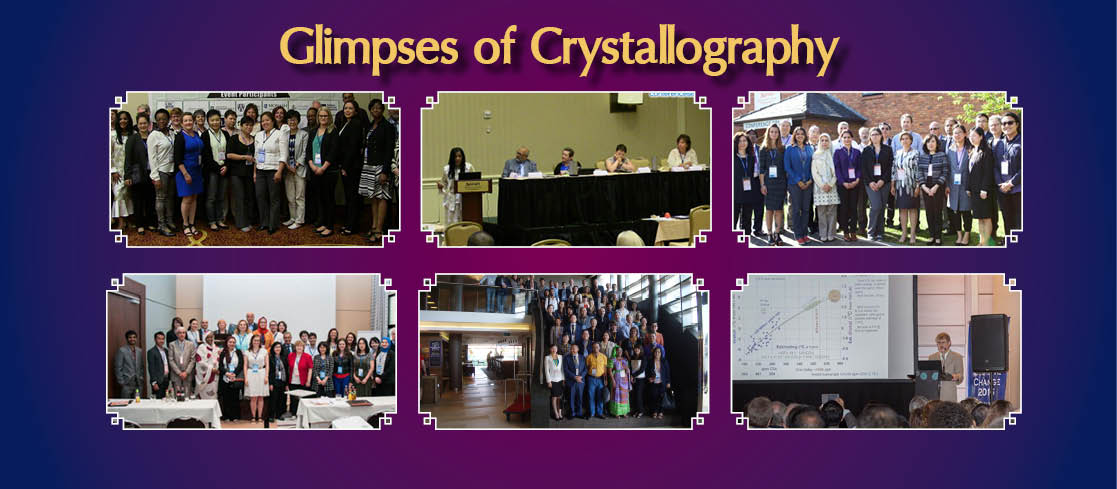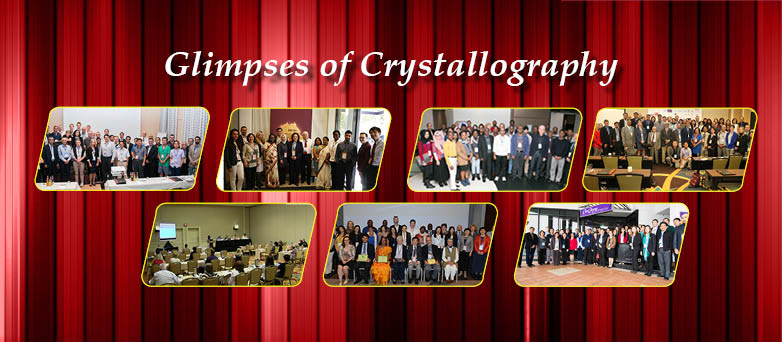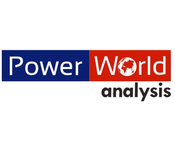Crystallography 2019
About conference
About Conference
SCA invites all the participants from all over the world to attend 4th edition of International conference on Applied Crystallography during Oct 14-18, 2019, Perth, Australia. Which includes prompt keynote presentations, Oral talks, Poster presentations and Exhibitions.
Crystallography 2019 provides a perfect symposium for scientists, engineers, directors of companies and students in the field of Materials science to meet and share their knowledge. The theme of conference is "Crystallography of today is the innovation of tomorrow".The scientific program paves a way to gather visionaries through the research talks and presentations and put forward many thought provoking strategies. It provides a premier technical forum for reporting and learning about the latest research and development, as well as for launching new applications and technologies. The Crystallization Market is segmented by technology, product, and end user. The market, by technology, is further segmented into protein purification, protein crystallization, protein crystal mounting, and protein crystallography. The Protein Crystallization segment accounted for the largest share of the protein crystallography market in 2013. However, the protein purification market will see the highest growth in the next five years. The research categorizes the protein crystallization & crystallography market on the basis of technologies (protein purification, protein crystallization, protein crystal mounting, and protein crystallography), products (analyzers and reagents), and end users (pharmaceutical companies, biotechnology companies, government institutes, and academic institutions). On the basis of technology, the protein crystallization segment accounted for the largest share-47%-of the market in 2015.
This event will focus on variety of Crystallography topics including, Protein crystallography, Crystallography in Biology, Chemical Crystallography, Crystallography in Materials Science, Electron crystallography, Crystallography Applications through invited plenary lectures, symposia , workshops, invited sessions and oral and poster sessions of unsolicited contributions.
Maximize your personal involvement, engagement by getting together on Oct 14-18, 2019 with an interactive discussions and workshops at the conference, you will feel free to reach out and share your thoughts to continue your lifelong learning and build on the skills that make you successful.
Target Audience:
· Eminent Scientists from Materials Science
· Chemistry Research Professors
. Junior/Senior research fellows from Universities
· Chemical Engineering Students
· Directors of companies
· Chemical Engineers
· Members of different Materials science and Mining and metullargy association
Market Analysis
SUMMARY
The 4th Edition of International conference on Applied Crystallography is the platform to gain or share the knowledge in the new technological developments in the field of science, engineering and technology. This conference brings together professors, researchers, scientists, students in all the areas of material science and nanotechnology and provides an international forum for the spreading of approved research. We are honored to invite you all to attend and register for the “4th Edition of International conference on Applied Crystallography” which is scheduled for Oct 14-18, 2019 at Perth, Australia.
The organizing committee is gearing up for an exciting and informative conference program this year also which includes plenary lectures, symposia, workshops on a variety of topics, poster presentations and various programs for participants from all over the world. We invite you to join us at International conference on Applied Crystallography, where you will be sure to have a meaningful experience with scholars from around the world. All members of the Crystallography 2019 organizing committee look forward to meeting you in Perth, Australia.
IMPORTANCE AND SCOPE
World-renowned speakers, the most recent techniques, tactics, and the newest updates in fields crystallography and engineering, tissue engineering are hallmarks of this conference. Crystallography 2019 is an exciting opportunity to showcase the new technology, the new products of your company, and/or the service your industry may offer to a broad international audience. It covers a lot of topics and it will be a nice platform to showcase their recent researches on Crystallography, Material Science and other interesting topics.
The study focusses on the processing of new materials which facilitates its applications to the next generation of engineers and its high marketability has a great impact on the economy of the country. In the new decade the sustainability and influence on the environment lie in the core of the material development.
WHY PERTH?
Perth is the capital city of Western Australia. It is the most populous region, urban zone and metropolitan area in Western Australia. Standing on the Swan River.
Perth is a leading global city, with strengths in the arts, commerce, education, entertainment, fashion, finance, healthcare, media, professional services, research and development, tourism and transport all contributing to its prominence. It is one of the world’s leading financial centres and has the fifth-or sixth-largest metropolitan area GDP in the world depending on measurement. Perth is a world cultural capital. It is the world’s most-visited city as measured by international arrivals and has the world’s largest city airport system measured by passenger traffic. Perth’s 43 universities form the largest concentration of higher education in Australia.
MARKET ANALYSIS
The future growth prospects for the protein crystallization & crystallography market are optimistic and it is estimated to grow at a CAGR of 10.1% to reach a worldwide market of $1,253 million by 2019. Australia’s proteomics market is forecasted to reach USD 9.35 billion by 2021, growing at a CAGR of 16.92%.
Factors propelling the growth of the Protein Crystallization & Crystallography Market include the increasing and immediate need for high-resolution information on protein structures, technological advancements, increasing government funding, and increasing R&D in the pharmaceutical and biotechnological arenas. On the other hand, factors restraining the growth of the market include dearth of qualified and experienced researchers, lack of generalized crystallization methods associated with the types of proteins, and highly time-consuming and expensive Protein Crystallization & Crystallography processes.
Emerging technologies like X-ray-free electron lasers, lab automation using liquid handling robotics, and automated workstations to reduce labour force and increase efficiency show promising prospects.
North America is the largest market, closely followed by Australia. Both markets will register high single-digit growth rates for the next five years. The Asian market is poised to grow at a double-digit rate owing to the increasing investment opportunities for companies in these immature markets and the increased focus of pharmaceutical and biotechnology companies towards the Asian region as an R&D outsourcing destination.
The market is dominated by Rigaku Corporation (Japan), followed by Hampton Research (U.S.), Jena Bioscience GmbH (Germany), Molecular Dimensions Ltd. (U.K.), Formulatrix, Inc. (U.S.), Bruker Corporation (U.S.), and MiTeGen LLC (U.S.).
GLOBAL MARKET
In this era proteomics, protein crystallography the technique is Widely Used to Determine the Three-dimensional structure of the protein. The data generated from various methods: such as X-ray crystallography, NMR spectroscopy, cryo-electron microscopy, gel electrophoresis alone or in combination are used to Determine The Structure of protein. With the use of crystallography technique, the number of crystal structures in the PDB Deposited has Increased over the past few years.
Crystallography technique has wide application in many industries: such as Pharmaceutical, Cosmetic, as well as food. Despite the structural complexity of the protein, the crystallography technique Facilitates structure-based drug design to target biological molecules SPECIFICALLY. This technique has led to effective treatments for many diseases by discovery of new antibiotics, drugs, and vaccines. The analysts forecast the Global Protein Crystallization and Crystallography market to grow at a CAGR of 10.15 percent over the period 2013-2018. This report covers the Present scenario and the growth prospects of the Global Protein Crystallization and Crystallography market for the period 2014-2018. To calculate the market size, the report considers revenue generated from the sales of various methods used to Determine the Structure of a protein using crystallography techniques.
The global market of material science is evaluated to reach a value of $6000 million by 2020 and is expected to inscribe a CAGR of 10.2% between 2015 and 2020. The north of America holds the largest market followed by Asia-Pacific. The Australia market is estimated to be growth at a steady rate due to economic recovery in the region along with the increasing concern for the building insulation and energy savings. The Australia market is estimated to be growth at a steady rate due to economic recovery in the region along with the increasing concern for the building insulation and energy savings. Embodied energy is the sum of all the energy associated with the construction of a building. The practice of demolishing a perfectly sound house has risen exponentially in the past 20 years, as small houses on large lots make way for higher density housing. House demolition Perth are one of a few good companies in Perth who reclaim or salvage as mush of the raw materials embodied in a building before demolition. We understand all too well, the environmental impact of the building industry and the enormous ammount of waste that makes itself into landfill rather than being reclaimed and resued.
Major Crystallography Associations around the Globe
· British Crystallography Association (BCA)
· Indian Crystallographic Association (ICA)
. Australiaan Crystallographic Association (ECA)
· French Crystallographic Association (FCA)
· Asian Crystallographic Association (ACA)
. Turkish National Crystallographic Association
. Croatian Crystallographic Association
. Czez and Slovak Crystallographic Association
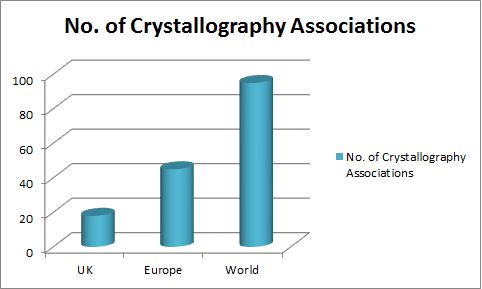
Statistical Analysis of Crystallography associations
Major Material Science Associations around the Globe
- American Chemical Society (ACS)
- American Physical Society (APS)
- The Materials Information Society (ASM International)
- The Materials Research Society (MRS)
- Microscopy Society of America (MSA)
- The Minerals, Metals & Materials Society (TMS)
- Sigma Xi: The Scientific Research Society
- International Society for Optical Engineering (SPIE)
- The American Ceramic Society (ACerS)
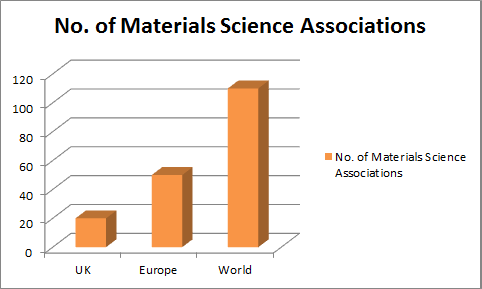
Statistical analysis of materials science associations
Target Audience:
- Materials Scientists/Research Professors/ Nanotechnologists
- Physicists/Chemists
- Junior/Senior research fellows of Materials Science/ Nanotechnology/ Chemical Engineering
- Directors of chemical/ Materials/ Nano companies
- Materials Engineers
- Members of different Materials science, Physics, Crystallography associations
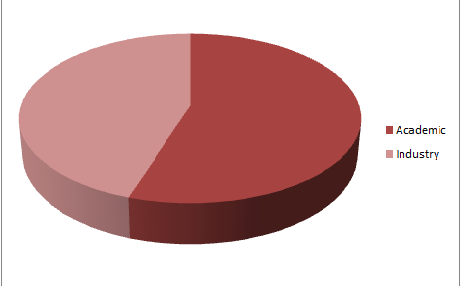
Graphical Representation of Attendance from different sectors
The global market analysis report in terms of graphical representation:
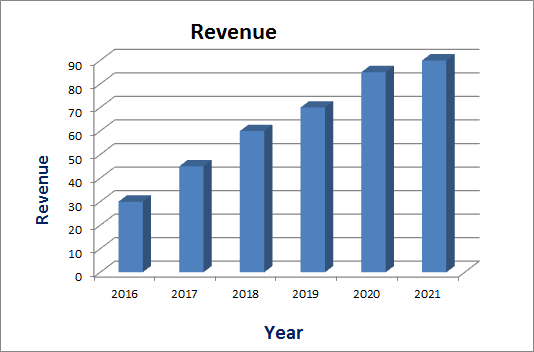
Statistical analysis of Crystallography global market revenue
Sessions/Tracks
Track1: Chemical Crystallography
Chemical Crystallography is a use of diffraction methods to the investigation of basic science. An incessant reason for existing is the recognizable proof of common items, or of the results of manufactured science tests; however point by point sub-atomic geometry, intermolecular collaborations and supreme designs can likewise be considered. Structures can be examined as an element of temperature, weight or the utilization of electromagnetic radiation, or attractive or electric field: such studies involves just little minority of the aggregate. The utilization of single precious stone X beam diffraction to decide the structure of a concoction compound has been generally delegated 'Substance Crystallography'. The strategies, the exactness in analyses combined with the modem PC contraptions and advances in innovation makes this branch of science an unequivocal supplier of precise and exact estimations of sub-atomic measurements. Structure assurance by powder diffraction, precious stone designing, charge thickness examination and studies on atoms in energized states are the late additional items.
· Engineering of Crystalline and Non-crystalline Solids
· Structure and Properties of Functional Materials
· Metal-organic Frameworks and Organic: Inorganic Hybrid Materials
· Reactions and Dynamics in the Solid State
· Small Molecule Crystallography: Novel Structures and General Interest
· Chemical Crystallography: General Interest
Track 2: Crystallography of Novel Materials
It ought to be obvious that all matter is made of iotas. From the intermittent table, it can be seen that there are just around 100 various types of molecules in the whole Universe. These same 100 molecules shape a great many distinctive substances running from the air we inhale to the metal used to bolster tall structures. Metals carry on uniquely in contrast to pottery, and earthenware production act uniquely in contrast to polymers. The properties of matter rely on upon which iotas are utilized and how they are fortified together. The structure of materials can be grouped by the general extent of different elements being considered. The three most basic real grouping of basic, recorded for the most part in expanding size, are: Atomic structure, which incorporates highlights that can't be seen, for example, the sorts of holding between the particles, and the way the iotas are organized. Microstructure, which incorporates highlights that can be seen utilizing a magnifying instrument, however sometimes with the stripped eye. Macrostructure, which incorporates highlights that can be seen with the exposed eye.
The nuclear structure basically influences the substance, physical, warm, electrical, attractive, and optical properties. The microstructure and macrostructure can likewise influence these properties yet they for the most part largely affect mechanical properties and on the rate of concoction response. The properties of a material offer intimations with regards to the structure of the material. The quality of metals proposes that these molecules are held together by solid bonds. In any case, these bonds should likewise permit molecules to move since metals are additionally typically formable. To comprehend the structure of a material, the sort of particles present, and how the iotas are organized and fortified must be known. We should first take a gander at nuclear holding.
· Metals and Alloys
· Ceramics and Polymers
· Thin films
· Quasicrystals
· Amorphous Materials
· Nanomaterials and Molecular crystals
· Structure of interfaces
· Novel crystallization strategies for XFEL studies
Track 3: Elecron Crystallography
It can supplement X ray-beam crystallography for investigations of small crystals (<0.1 micrometers), both inorganic, natural, and proteins, for example, layer proteins, that can't undoubtedly frame the substantial 3-dimensional precious stones required for that procedure. Protein structures are generally decided from either 2-dimensional gems (sheets or helices), polyhedrons, for example, viral capsids, or scattered individual proteins. Electrons can be utilized as a part of these circumstances, while X ray-beams can't, on account of electrons interface more emphatically with molecules than X-beams do. In this way, X-beams will go through a thin 2-dimensional precious stone without diffracting altogether, though electrons can be utilized to shape a picture.
On the other hand, the solid communication amongst electrons and protons makes thick gems impenetrable to electrons, which just enter short separations. One of the primary troubles in X ray-beam crystallography is deciding stages in the diffraction design. On account of the unpredictability of X-beam focal points, it is hard to frame a picture of the gem being diffracted, and subsequently stage data is lost. Luckily, electron magnifying instruments can resolve nuclear structure in genuine space and the crystallographic structure calculate stage data can be tentatively decided from a pictures Fourier change.
· Microscopic Techniques
· Inorganic Crystal Studies
· Structural Determinations
· Mass Spectrometry
· Fluorescence Anisotropy
· Chemical Modifications
· Molecular Docking
· Cryo-electron microscopy (cryo-EM)
Track 4: Advanced Crystallography
Precious stones are generally connected with having normally grown, level and smooth outer countenances. It has for quite some time been perceived that this confirmation of outside normality is identified with the consistency of inside structure. Diffraction strategies are presently accessible which give substantially more data about the inside structure of precious stones, and it is perceived that interior request can exist with no outside confirmation for it.
· Computational Crystallography
· Industrial Crystallization
· Functional Crystals
· Organic & Inorganic Crystals
· Metal-Organic Frameworks (MOFs)
· Biomacromolecules
· Supramolecular Crystallography
· Pharmaceutical Co-crystals
· 2D CrystalEngineering
· Porous and Liquid Crystals
· Nuclear Magnetic Resonance methods
· Powder diffraction
Track 5: Crystallography in Biology
Basic science can help us to see a portion of the detail missing from this view and thusly is an intense device to unpick the complex and lovely choreography of life. For quite a long time, we have possessed the capacity to picture structures inside a cell, yet even the most intense magnifying instruments are constrained in the detail they give, either by the sheer physical limits of amplification, or in light of the fact that the examples themselves are not alive and working. Auxiliary science strategies dive underneath these points of confinement breathing life into particles in 3D and into keener core interest. It scopes to the very furthest reaches of how an atom functions and how its capacity can be adjusted. The way toward deciding sub-atomic structure can be long and disappointing – here and there taking years. Generally, proteins are the objectives for structure investigation as these are the principle "doing" particles of the cell. Proteins are worked from a DNA layout and the string of amino acids subsequently combined overlay into extremely complex circles, sheets and curls – it may appear like a tangle, yet this structure directs how the protein will communicate with different structures around it keeping in mind the end goal to attempt its obligations in the phone. The exquisite structures of particles and the buildings they shape can be amazing in their rationale and symmetry, yet they are additionally incomparable in helping us to see how cells really function. All of a sudden shapes, sizes and congregations of atoms can be doled out to different compartments in cells and put into setting with their encompassing surroundings. A key point of basic cell science is to manufacture a scene representation of cell capacity. The emanant picture will be much the same as a modern and element city where sub-atomic connections are fashioned and broken, short-or extensive and all are formed by the certainty of cell proliferation, maturing and passing.
· Membrane Proteins
· Macromolecular Complexes and Assemblies
· New tools and methods in structural biology
· Structural plasticity of proteins
· Hot Structures in Biology
· Structural biology of signalling pathways
Track 6: Crystallographic Defects
Crystalline solids exhibit a periodic crystal structure. The positions of atoms or molecules occur on repeating fixed distances, determined by the unit cell parameters. However, the arrangement of atoms or molecules in most crystalline materials is not perfect. The regular patterns are interrupted by crystallographic defects.
· Point Defects
· Line Defects
· Planar Defects
· Bulk Defects
Track 7: Crystall Growth
X-beams are utilized to examine the basic properties of solids, fluids or gels. Photons interface with electrons, and give data about the vacillations of electronic densities in the matter. A run of the mill test set-up is appeared on Figure 1: a monochromatic light emission wave vector ki is chosen and falls on the specimen. The scattered power is gathered as a component of the alleged dissipating point 2θ. Versatile cooperation’s are described by zero vitality exchanges, with the end goal that the last wave vector kf is equivalent in modulus to ki. The applicable parameter to examine the collaboration is the force exchange or diffusing vector q=ki-kf, characterized by:

The scattered force I(q) is the Fourier Transform of g(r), the connection capacity of the electronic thickness r(r), which compares to the likelihood to discover a scatterer at position r in the specimen if another scatterer is situated at position 0 : flexible x-beam dissipating tests uncover the spatial relationships in the example. Little edge diffusing analyses are intended to quantify I(q) at little scrambling vectors q»(4p/l)q, with 2q going from couple of small scale radians to a ten of radians, to examine frameworks with trademark sizes running from crystallographic separations (few Å) to colloidal sizes (up to couple of microns).
· Nanocrystallography
· Recent Developments in Crystal Growth
· Crystal growth kinetics and mechanisms
· Crystallization techniques
· Crystal morphology
· Diamonds growth
· Oragnic Crystal Scintillators
Track 8: Recent development in the X-ray studies
X-beam free-electron lasers (XFELs) open up new potential outcomes for X-beam crystallographic and spectroscopic investigations of radiation-touchy natural examples under near physiological conditions. To encourage these new X-beam sources, customized test strategies and information preparing conventions must be created. The profoundly radiation-touchy photosystem II (PSII) protein complex is a prime focus for XFEL tests intending to concentrate on the instrument of light-actuated water oxidation occurring at a Mn bunch in this complex. We built up an arrangement of instruments for the investigation of PSII at XFELs, including another fluid fly in view of electro focusing, a vitality dispersive von Hamos X-beam emanation spectrometer for the hard X-beam extend and a high-throughput delicate X-beam spectrometer in light of a reflection zone plate. While our prompt center is on PSII, the techniques we portray here are appropriate to an extensive variety of metalloenzymes. These exploratory advancements were supplemented by another product suite, cctbx.xfel. This product suite considers close constant checking of the exploratory parameters and identifier signals and the itemized examination of the diffraction and spectroscopy information gathered by us at the Linac Coherent Light Source, considering the particular attributes of information measured at a XFEL.
· Advances in X-ray and Neutron Crystallography
· Synchrotron Radiation Application
· Hybrid/Integrative Methods in Biological Structure Analysis
· Electron Diffraction in Crystallography
· Bio-imaging
· Laser physics and applications
Track 9: Crystallography Applications
Crystallography method has been a broadly utilized device for illustration of mixes present in drain and different sorts of data acquired through structure work relationship. Albeit more point by point data from X-beam investigation has been secured from substances which are normally known to be crystalline, it has been amazing to discover substances generally considered as being non-crystalline as really having a halfway crystalline structure and that this structure can be changed by warmth treatment, weight, extending, and so forth. Casein is a case of the last class of proteins. Stewart has demonstrated that even arrangements have a tendency to accept a methodical game plan of gatherings inside the arrangement. Consequently, fluid drain ought to, and shows some sort of course of action. The mineral constituent and lactose are the main genuine crystalline constituents in dairy items that can be investigated by X-beam; in any case, intriguing basic changes have been seen in butterfat, drain powder, casein and cheddar.
· High-Resolution Charge Density Studies
· Semiconductors and Insulators
· Pre-clinical imaging
· Small molecule crystallography
· Spectroscopy at Fusion Reactors
· Surface Stress Measurements
· Resonance Diffraction
· Photo-Crystallography
Track 10: Crystallographic Companies and Market Analysis
Australia accounted for 33% market share in global nanotechnology market revenue in 2015 after Americas region and is forecast to grow at a CAGR of 15.6% to reach $3.98 billion by 2021. APAC region is projected to grow at a rate of 20.9% CAGR during the forecast period 2016-2021.The analysis report informs that the global nanoparticle market is expected to reach USD 91.1 million by 2020 at a CAGR of 5.4% from 2015-2020. The market growth is being improved due to the increased emphasis on Nano technological research and funding provided by the government to carry out the R&D in this domain. The markets of China, Brazil, India and South Africa are attaining high growth prospective for the companies involved in R&D of nanotechnology and nanoparticle analyzing instruments distribution.
